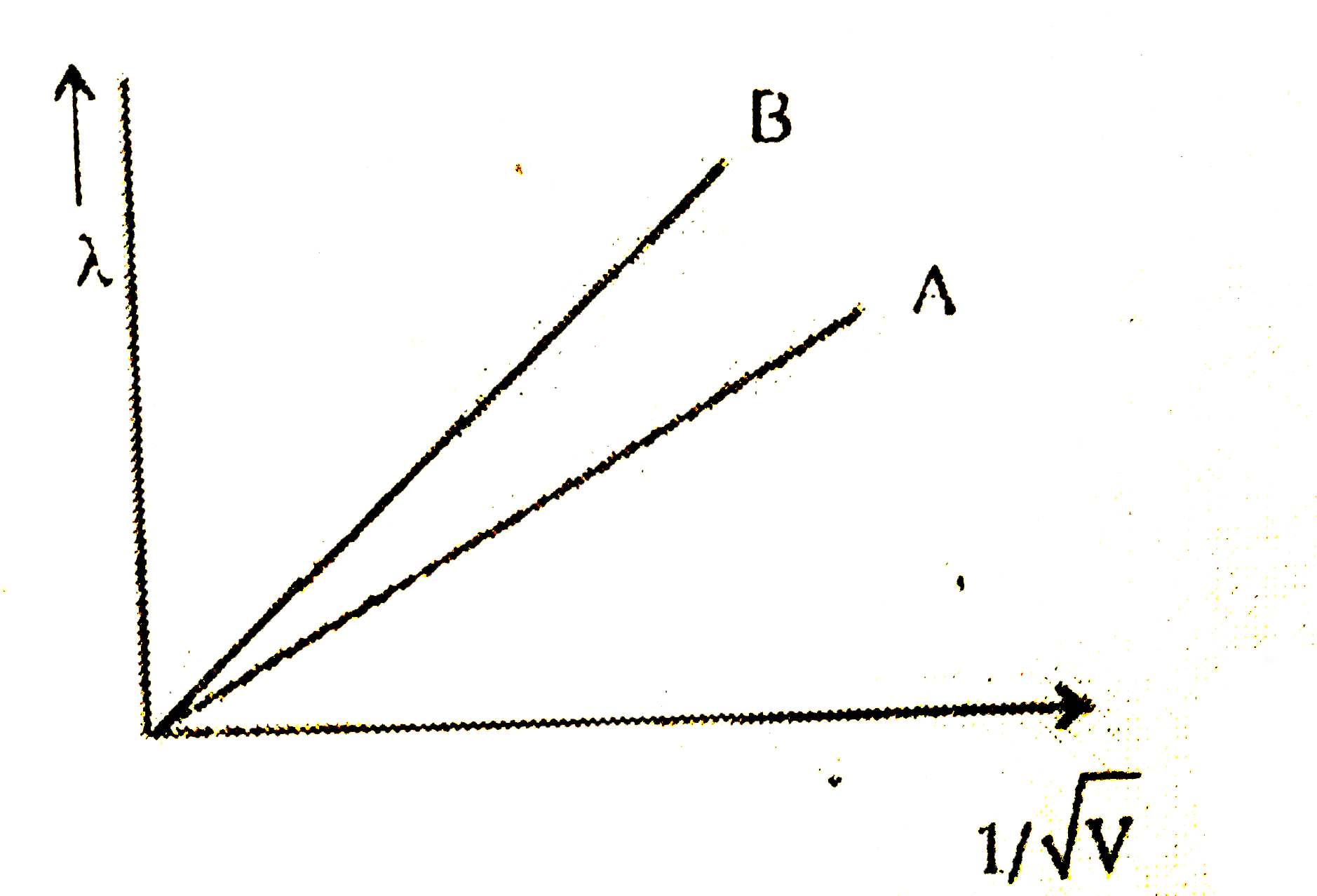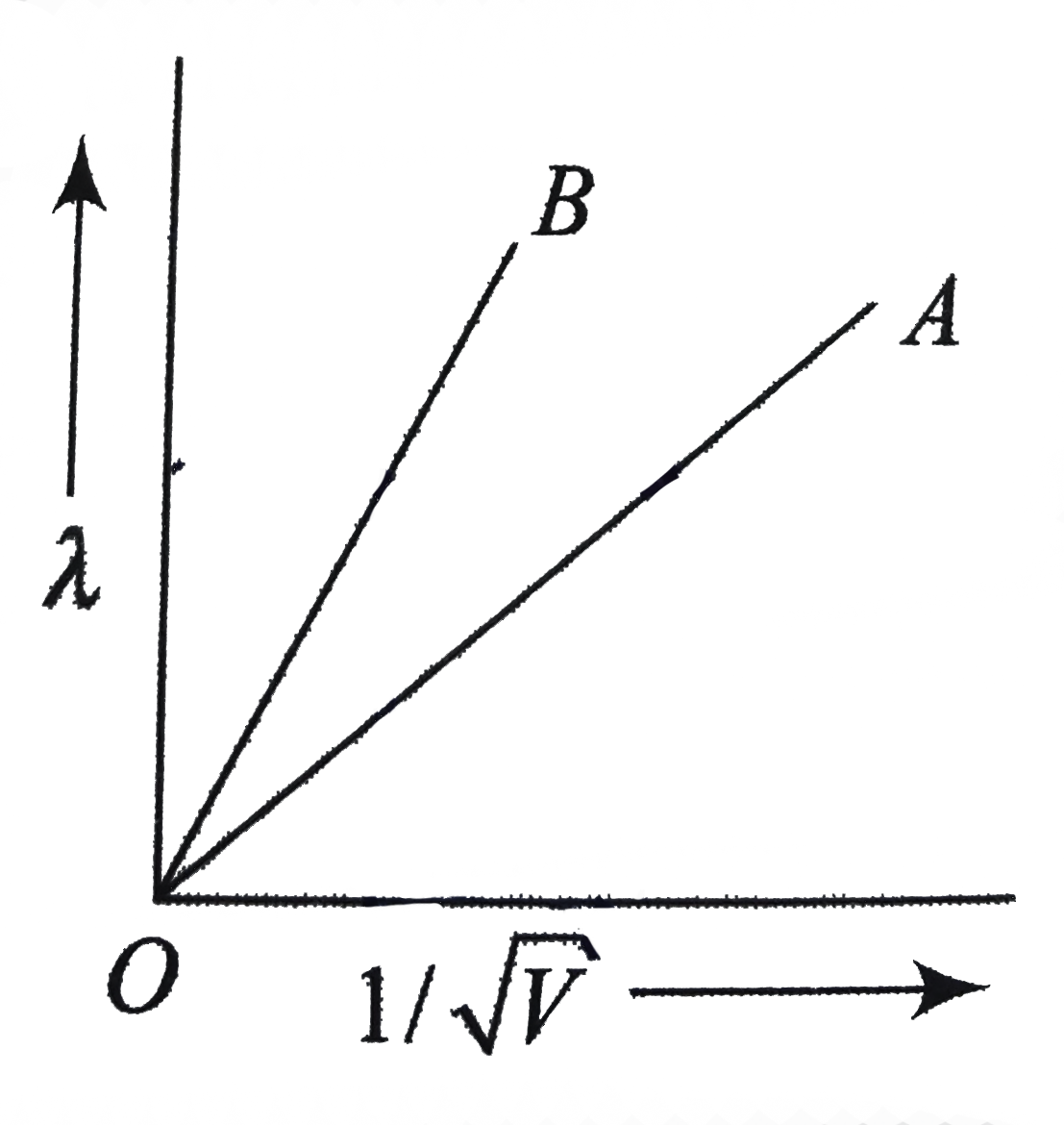![Two lines A and B in the plot [figure] show the variation of de-Broglie wavelength lamda versus (1)/(sqrt(V)), where V is the accelerating potential difference, for two particles carrying the same charge. which one of the two represents a particle of smaller mass ?](https://d10lpgp6xz60nq.cloudfront.net/physics_images/U_LIK_SP_PHY_XII_C11_E08_026_Q01.png)
Two lines A and B in the plot [figure] show the variation of de-Broglie wavelength λ versus 1√V, where V is the accelerating potential difference, for two particles carrying the same charge. which one of the two represents a particle of smaller mass ?
We know that λ=h√2mqV. Thus, slope of λ−1√V graph is inversely proportional to square root of mass. As slope of line B is more hence it represents a particle of smaller mass i.e., m2<m1.
Topper's Solved these Questions
- DUAL NATURE OF RADIATION AND MATTERBook:U-LIKE SERIESChapter:DUAL NATURE OF RADIATION AND MATTERExercise:SHORT ANSWER QUESTIONS
Explore 27 Videos
- DUAL NATURE OF RADIATION AND MATTERBook:U-LIKE SERIESChapter:DUAL NATURE OF RADIATION AND MATTERExercise:LONG ANSWER QUESTIONS
Explore 19 Videos
- DUAL NATURE OF RADIATION AND MATTERBook:U-LIKE SERIESChapter:DUAL NATURE OF RADIATION AND MATTERExercise:ASSERTION REASON TYPE QUESTIONS
Explore 5 Videos
- CURRENT ELECTRICITY Book:U-LIKE SERIESChapter:CURRENT ELECTRICITY Exercise:SELF ASSESSMENT TEST (SECTION C )
Explore 3 Videos
- ELECTRIC CHARGES AND FIELDS Book:U-LIKE SERIESChapter:ELECTRIC CHARGES AND FIELDS Exercise:SELF ASSESSMENT TEST (SECTION-B) (VERY SHORT ANSWER QUESTIONS)
Explore 4 Videos
Similar Questions
Two lines, A and B, in the plot given below show the variation of de-Broglie wavelength, λ versus 1/√V, where V is the accelerating potential difference, for two particles carrying the same charge. Which one of two represents a particle of smaller mass?

View SolutionTwo lines, A and B, in the plot given below show the variation of de-Broglie wavelength, λ versus 1/√V, where V is the accelerating potential difference, for two particles carrying the same charge. Which one of two represents a particle of smaller mass?

View Solution
Knowledge Check
The de-Broglie wavelength λ associated with charged particle of charge q, mass m and potential difference V is
Ah√2mqVBh2√2mqVCh√mqVDh√2qVThe ratio of de-Broglie wavelength associated with a proton and a μ-particle accelerated through the same potential difference 'V' is
A1:2B1:1C1:2√2D1:4
Plot a graph showing variation of de-broglie wavelength λ versus 1/√V, where V is accelerating potential for two particle A and P carrying same charge but of masses m1andm2(m1>m2). Which one of the two represents a particle of smaller mass and why?
View SolutionPlot a graph showing variation of de-broglie wavelength λ versus 1/√V, where V is accelerating potential for two particle A and P carrying same charge but of masses m1andm2(m1>m2). Which one of the two represents a particle of smaller mass and why?
View SolutionPlot a graph showing variation of de-broglie wavelength λ versus 1/√V, where V is accelerating potential for two particle A and P carrying same charge but of masses m1andm2(m1>m2). Which one of the two represents a particle of smaller mass and why?
View Solution
The two lines A and B in fig. shows the plot of de- Broglie wavelength (λ) as a function of 1√V(V is the accelerating potential) for the particles having the same charge. Which of the two represents the particle of heavier mass?
View Solution
The two lines A and B in fig. shoe the phot of de Broglie wavelength (λ) as a function of 1√V(V is the accelerating potential) for teo particles having the same charge. Which of the two represents the particle of heavier mass?
View SolutionPlot a graph showing variation of a de Broglie wavelength (λ) associated with a charged particle of mass m, verses 1/√V, where V is the potential difference thrugh which the particle is accelerated.
View Solution
